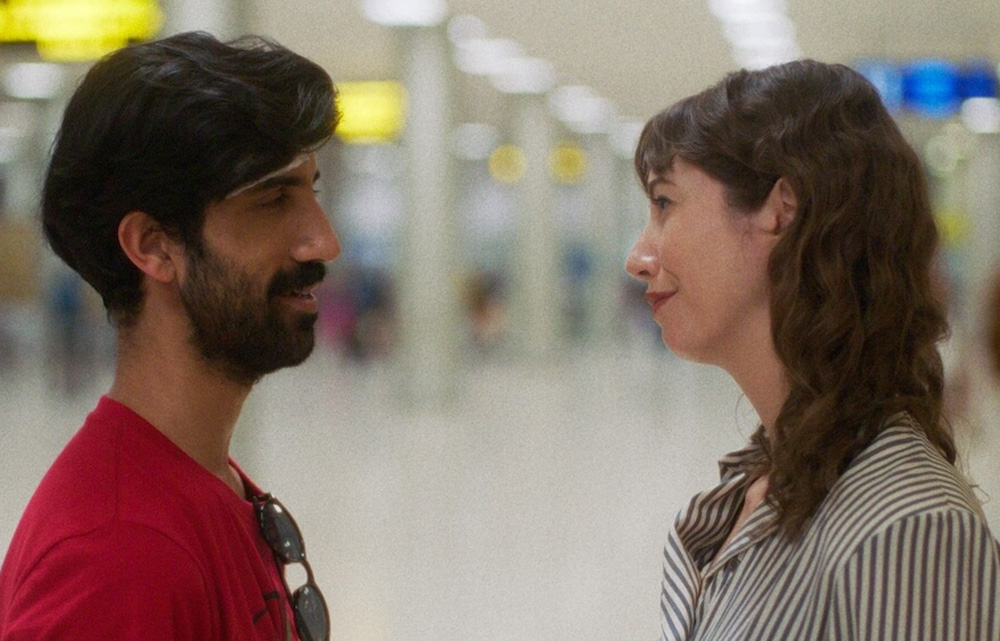One of the best introductions to a film I’ve ever seen happened earlier this year at South by Southwest where in all earnestness, Shaun Seneviratne declared that his debut feature “Ben and Suzanne, a Reunion in Four Parts” was his favorite film. “I’ll put it on while I’m washing dishes,” he said without a trace of hubris in his voice, only deep, deep enthusiasm for the film he had spent the past decade working towards with its two lead actors Anastasia Olowin and Sathya Sridharan, making the logical case that if you put that much time and energy into something, it should be something you enjoy yourself. After taking a poll of filmmakers in the audience who might’ve been sick of watching their own work when having to endure scrutinizing the same footage again and again in the editing room, Seneviratne promised that the moment he was having now, standing in front of an audience for the premiere could make it all worth it.
“When I said it’s my favorite movie, it’s not in an arrogant way. It’s really just that for every director why you should make a movie is that it’s a movie you would want to see,” says Seneviratne on the eve of the film’s west coast premiere at the Indian Film Festival of Los Angeles this weekend. “And if you do that, then maybe other people will feel the same way, like if you make your own favorite movie, then that could be someone else’s favorite movie.”
All of that ran the risk of coming across as an empty platitude if Seneviratne couldn’t back it up, but any fears of that cleared up less than a few seconds into his delightful Sri Lankan adventure that promises to be a favorite for some time to come on the festival circuit and beyond. The premise is simple enough as the long-distance couple of the title has located two weeks in their busy lives to share the same hotel room, with Suzanne, an American working abroad for an NGO plotting out a trip in which her New Jersey-based boyfriend can see the sights of Sri Lanka while she collects information from locals for a microloan project she’s working on. Mixing business with pleasure is a bad idea of Suzanne’s from the start and Ben has some of his own, bringing with him a Toblerone Bar the size of healthy five-year-old child to show his love for her, and soon their misjudgments about what this rendezvous actually means to each other may be the primary way they’re on equal footing these days when their time together starts to feel as if they’re waiting for a bad relationship to end rather than taking it to another level.
Still, “Ben and Suzanne, A Reunion in Four Parts” is an exuberant romantic comedy where any discontent becomes part of the crackling chemistry between Olowin and Sridharan, whose characters may no longer be compatible, but couldn’t feel more natural together as a couple on the outs, seizing on anything that reminds them of the person that they were so strongly attracted to in the first place while gradually starting to realize that memory may be getting in the way of seeing one another for who they are now. Funny, profound and full of passion for the cinema that fills the void of whatever love has been lost between its central characters, the film establishes Seneviratne as a world-class filmmaker, which makes the film’s stop in L.A. a comfortable fit at IFFLA amongst new films from Tarsem (“Dear Jassi”), Lucy Walker (“Mountain Queen: The Summers of Lhakpa Sherpa”), Shuchi Talati (the Sundance-celebrated “Girls Will Be Girls”) and Nikhil Nagesh Bhat (the TIFF Midnight Madness sensation “Kill”). On the eve of the start of the four-day fest kicking off tonight at the Landmark Sunset Five, Seneviratne generously spoke about feeling out what would become his first feature over nearly 10 years, turning what was his own rough experience with an ex into such a lovely reflection on relationships and taking in stride all the hitches on the road to making it.
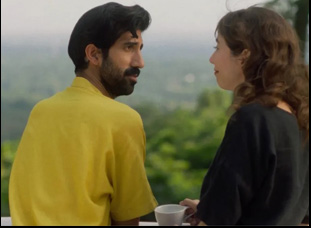
I always had the dream to be a director, and and I minored in cinema studies, but I [primarily] studied marketing and journalism and I was in this long-distance relationship [at the time]. She went to work at an NGO in India, and I go over there to see her during the winter break, and think it’s going to be this amazing romantic reunion, but it’s not that, and when it’s not what you think it’s going to be, it can be very heartbreaking. Then you’re trying to negotiate these two weeks together where we kind of broke up in the beginning, but we’re figuring out how to be together for two weeks while traveling. It was a terrible, hard experience, but while going through that, I thought “This sucks, but this could be a great movie,” and I was always interested in being a director, but the reason I make movies, period, is because I needed to make this movie.
That’s what started this long journey to get here, and then 10 years ago when we did the [initial] short, and then we’ve made three shorts since then, so inadvertently, we’ve done our own “Before” trilogy, which was like the dream — the way Richard Linklater, Julie Delpy, and Ethan Hawke all work together. That’s what I always wanted to do, and then that happened very incidentally, so the only dream of my adult life was to make this movie, and now I need new dreams. [laughs]
What was it like to have Sathya and Anastasia come aboard like that and you get to build this together?
Truth be told, before they came on board, these characters were just ideas, loosely based on experiences that I’d been through, but it wasn’t until I met them [where I realized], “Oh, these are the characters.” I auditioned a couple people, and I wrote the film in a very novelistic, poetic way, so it wasn’t like “Here’s the script, and this is what you’ve got to do,” but when I met them individually, it was more vibe-based and when we did the audition, we weren’t reading lines from the script, but [I’d say] “You’re having lunch with a friend, you’re about to go to India, just talk to me as your friend about what you’re feeling.” That’s what really allowed me to see how every actor interpreted the character and their circumstances in different ways.
When I first met Anastasia, I [thought], “She’s giving me things that I didn’t even consider and think about” and it formed the character through that audition. It was the same with Sathya where it wouldn’t be what it is if I did not meet them, because they are [these characters], and their ideas and their skills as actors and my ideas, everything coming together is what built these characters up over 10 years.
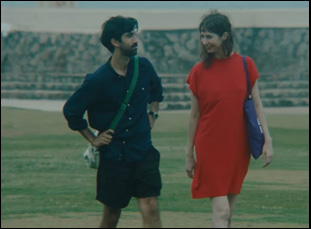
Meeting Anastasia and Sathya was the first major critical thing, and then switching [the setting] to Sri Lanka was the second major critical thing. My wife, Christine, who also does wardrobe in the movie, [as well as wrote] the poem, had suggested years ago, “Why don’t you shoot in Sri Lanka?” You have family there, and it would be easier.” At the time, I was very much like, “But the story happened in India, so I’ve got to be true to the story.” Then I was there with my mom in 2021, right before she had passed away, and we were driving with her driver at the time, and I was telling them the story about this movie, and my mom’s like, in that slightly scolding mom tone, “Why are you making a movie in India? This is your home and this is a beautiful place. You need to do something to put it out there in the world.” And I regurgitated the same excuses and she’s like, “But why does that matter?” And I [thought], “why does that matter?And what would happen if I switched things to Sri Lanka?”
That gave me a certain kind of freedom and distance, where it was like certain things are influencing it, but now I get to be a little bit looser with it, and just really create a story, as opposed to a documentary record of what had happened to me. It really became its own thing, and that only came to be because we chose Sri Lanka. It also really got to be a homecoming for me. That was the most I’ve ever spent in the country, and I got to learn more about my country, and my people, and my family, being there in Sri Lanka, making this movie with our Sri Lankan crew. Meeting Sathya and Anastasia defined the characters, but moving to Sri Lanka is what made “Ben and Suzanne.”
Did the geography of the country give this a dramatic structure since this is a road movie?
Yeah, because we knew we wanted to go all over the place and we knew we wanted to start in Colombo, because that’s the city where everyone’s going to land and then we go to more rural areas, where more of Suzanne’s work is. Then we go to the beach area, where it should feel like vacation again, but it doesn’t quite feel that way. Through that, we got to really define “If we’re starting in Colombo, the modern capital, maybe our next location should be Anuradhapura, which is the ancient capital, and then you go to Sigiriya, which is like this rock fortress, and then you get a sense of what life might have been like 500 years ago and you see Suzanne’s home and how she’s living. That’s where we really start to understand that she is living a totally different context and life from what anyone would expect and that helped define the arc of the movie.
And it is a proper road movie. There’s a lot of road movies where they’ll do the driving stuff with a process trailer that’s pulling the car with a camera on it behind it, but this is a camera in the van and we’re really driving through the country. We went to 40 different locations across 17 days all across Sri Lanka, in the middle of a strike where we had to stop production for a week. It was a wild experience. We also went into production with a scriptment, so after working for 14 years on these scripts, I didn’t have a finished script by the time we started shooting. And I’m so happy we didn’t because the strike definitely shook things up. I went in and I was cutting things left and right and reorganizing things. I also wanted to be loose, because a road movie needs to have the spontaneity and to stay true to the experience of what we would experience traveling. For example, the van breaking down was influenced by stuff that happened on the location scout, so we really were able to bring in our experience on this trip into the movie.
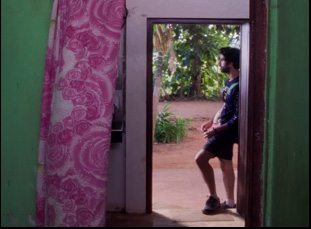
Most things either were in the script or I rewrote the script the morning of, so literally while the actors are in makeup, I’d hand them pages, like, “Sorry guys, I rewrote everything.” But there’s a great Francois Truffaut quote where he talks about he wants everyone on set to behave like they have 104 degree fever, and something about that really hit me where there’s an urgency and an unexpectedness that then brings an energy to what it is that you’re doing, so there were spontaneous elements to it, but then we had been working on it for so long and my relationship with Sathya and Anastasia is so collaborative and they very much knew these characters, so Anastasia would [say], “I don’t know if this feels right for what Suzanne would do, or Sathya would say like, “Maybe it’d be interesting if I try this.” And when I’m directing, I’m not trying to look for a result and to be honest, in a lot of ways, I don’t know exactly what I’m looking for, but I want to be surprised, so I get these many takes and then in the edit, we have a lot of fun deciding, “If we tried this take, it totally changes the tone versus this take” and I want to give myself that opportunity for surprise and really just make sure there’s an element of play to everything that we’re doing when we’re rolling camera.
It’s got such a lively soundtrack. What was it like to put music on this?
I come from a music background, so music to me is really important and there’s so many musical ideas that I’d been influenced by for so many years. Once we got to the edit, we were trying things out, like finding saxophone versions of emo songs. And then our editor Joe [said] I feel like we need to do something that has its own fingerprint. And when he was at my house for New Year’s, I showed him this digital Tanpura and Tabla that I bought in Sri Lanka, which creates the drum sounds and the drone sounds [respectively]. So he [told me] “Record two hours of music and send it to me.” So I’m just there in my living room and I just recorded lots of drone sounds and lots of Tabla sounds and then he just found all the sections that he wanted to use. I was like, “Whoa, this like feels totally unique because it’s also digital and it’s has a unique tone to it.”
Then for the other music, we got to have a lot of fun. We have this beautiful Sri Lankan song by C.T. Fernando, like the Nusrat Fateh Ali Khan or Elvis of Sri Lanka, for the opening. My wife discovered that song as we were trying to find Sri Lankan music. And then I do have some emo songs in there. Rainer Maria, which is a seminal ’90s emo band, are friends of mine now and they contributed music and then for the hotel scenes, that’s where we got a little more fun with it. We have an amazing composer that came on, Jake D’Ambra, who’s also a great saxophone player and that’s where we wanted to bring the idea of what does hotel music sound like combined with these Sri Lankan sounds, but influenced by pop music? I was thinking of that ’80s thing where it’s earnest and sincere, on the verge of cheesy, but it’s cheesy because it’s emotional and you’re on the verge of something special. One of my favorite parts of post production was working on the music and I think it is an important singular aspect that I think a lot of directors sleep on. They’ll be content with, “Okay, now this is a sad scene, so we hear sad piano.” And if I hear another fucking sad piano song again, it drives me crazy. It’s not commenting on the work in any kind of interesting way. So I’m very proud of the soundtrack that we were able to create.
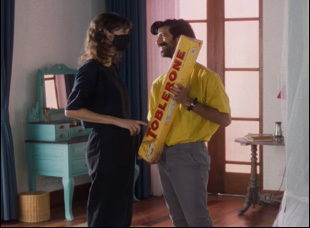
I was just thinking about travel and Toblerone is such a such a marker of international travel specifically, right? You travel to Europe or to Asia, and you go to the duty free shop and what do you see? You see the whole display of Toblerone. And I thought [Ben] should definitely come with gifts, and I already had the idea “What if she’s vegan now? So this is something that he didn’t discover about her and he comes with all this chocolate.” Then I thought, “What’s the biggest Toblerone bar that exists?” I looked it up, and I was like, “Yeah, that’s what I need.” I ordered it in the U.S. and it didn’t fit into my luggage [going to Sri Lanka], so I needed to check the Toblerone as its own separate baggage and had to pay a separate [fee] for it. Then when we get to Sri Lanka, it fell off the conveyor belt, so we thought we lost it.
Ben’s journey in the movie with the Toblerone bar was my journey in life — I was the one bringing it from the hot van into the cold hotel room back into the van and at the wrap party, we finally busted that Toblerone bar. And one fact about the Toblerone bar. When Sathya had to eat it, Sathya is allergic to nuts, so we had the chefs at the hotel restaurant [where we were staying], who were so nice and awesome, make us a triangular shaped giant piece of chocolate without nuts, so in the scene, that’s what he’s eating. He’s like ripping that open and it’s not the actual Toblerone bar.
You just blew my mind. So what’s it been like traveling without the Toblerone bar, but now with this entire film?
You make a movie because you want to make a movie and I don’t make a movie with a goal in mind because you can’t control that. All you can control is what you can do. We submitted our rough cut to Sundance and South By, literally the first cut, and we hear back from Sundance and didn’t get in. They sent a very nice personalized letter from the programmer talking to me about the movie where it wasn’t just like “You’re rejected,” so I already felt, “Okay, this is nice.” I felt good about that. Then it’s midnight and I’m looking at my e-mail and I see that an e-mail from South by Southwest had come in and I just assumed it was a rejection, but I click on it and I start reading it. I’m like, “Oh, shit.” Premiering at South by Southwest has been a huge benefit to the movie because it really adds a certain cachet to it. There’s no major stars. This is like “Clerks,” a true indie movie and I really feel like now it’s like the indie movie that could. It’s building this nice buzz cult following, which feels appropriate for an indie movie like this and I think that’s for the best — it shouldn’t be saturated, but just catch on by by word of mouth.
We just played at Brooklyn Film Festival as our hometown premiere and it was one of the best days of my life. It felt like the end of “Big Fish” where it’s like, “Oh my God, these are my people and this is my community, and I get to share this movie with them.” It was very emotional. This is a big month with a lot of festivals, and I’m just very excited and happy. But I also feel free because I’ve been working on this for so long. As I was saying, this is the only dream of my adult life, and now I have 10 ideas of new things I want to do and I’m excited to explore something that’s not going to take me another 14 years to do.
“Ben and Suzanne, a Reunion in Four Parts” will screen at the Indian Film Festival of Los Angeles on June 29th at noon.




